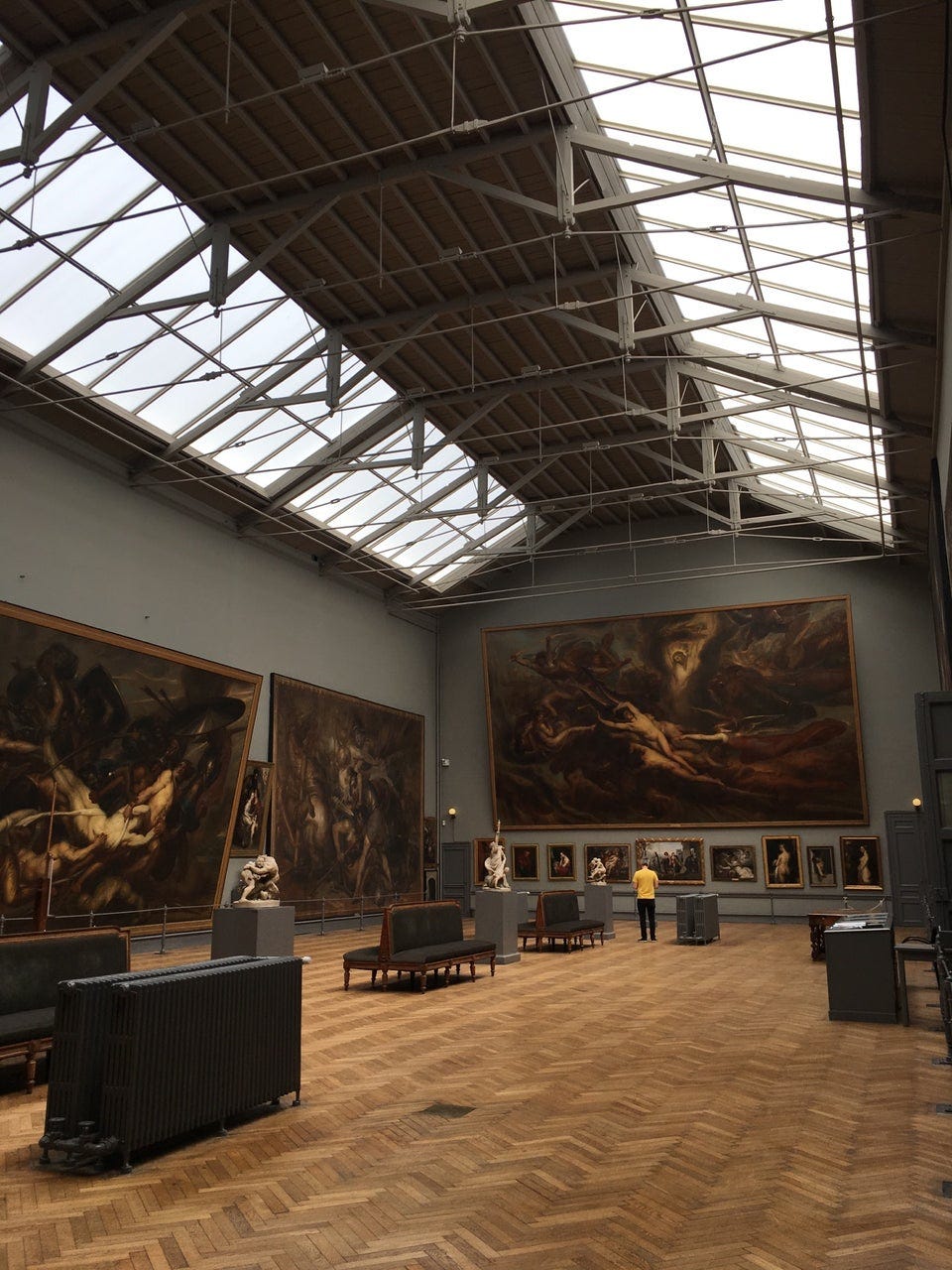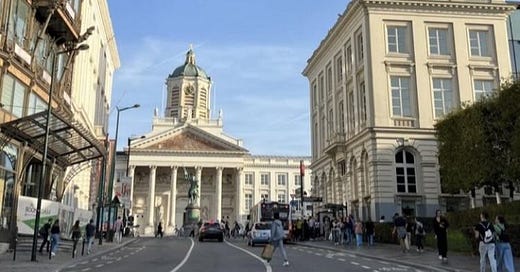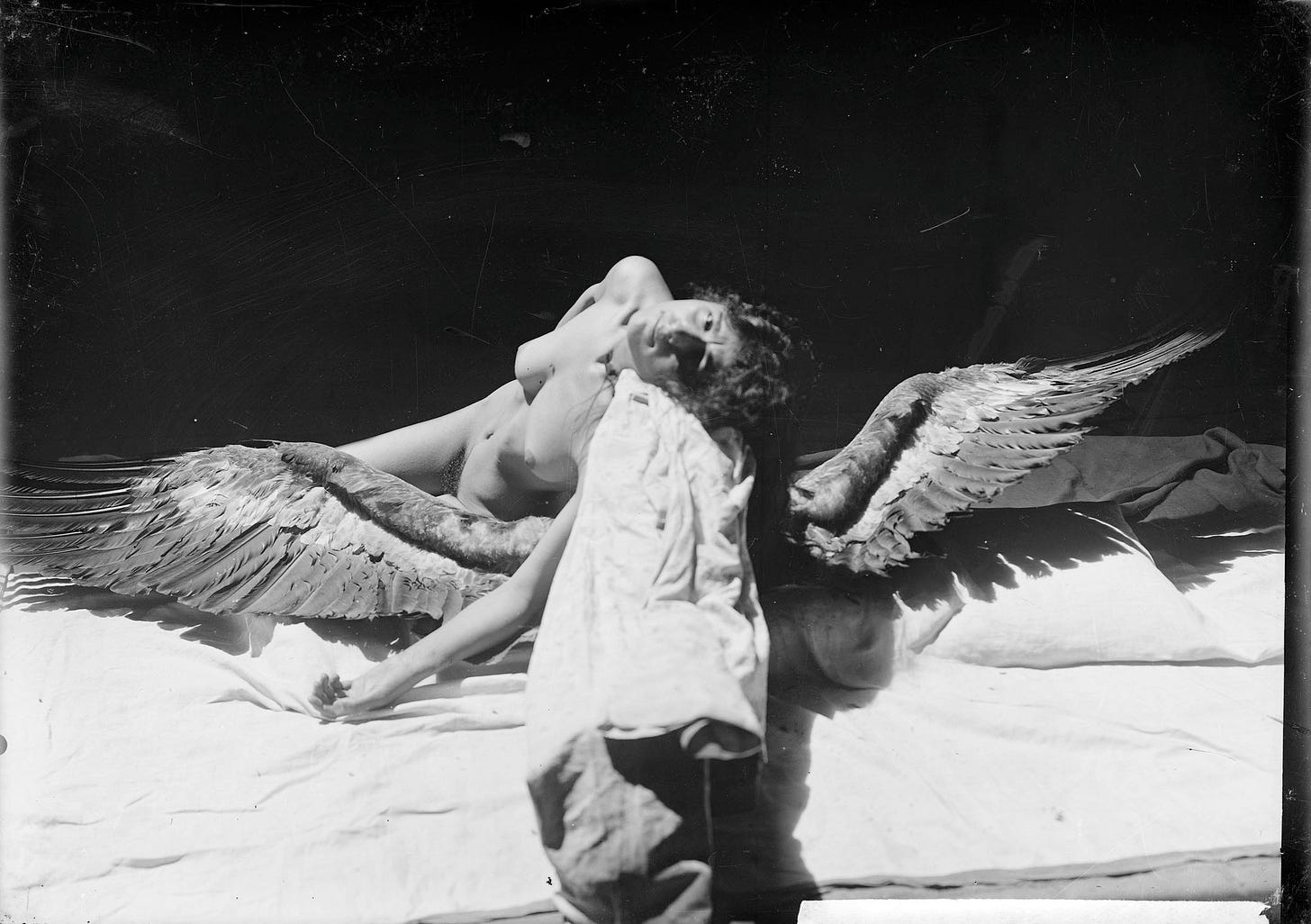Bienvenue à Magritteland™
A recent trip to Brussels reminded me of the magic of Magritte and the heroic spectacle of Wiertz.
While in my hotel room in Brussels I tuned in the television to an arts discussion programme. I rarely watch television except when in hotels and passing by screens in public spaces. After a day of constant walking and standing around a city – detached from the umbilical cord of the internet – I might turn on a news programme or a new film (i.e. one released in the last decade) dubbed into one of the languages I can vaguely follow. The sheer novelty of having access to a television is more of a distraction than anything I actually see (I can’t say “watch”) on the screen. “Mont des Arts” discussion programme had the chyron “Brussels Museums – is the latest step too far?” It was about the importance of cultural tourism to the economy of Brussels. The prompt was the latest initiative: a night of the museums – already a familiar concept to residents of Berlin and other major European cities – where 33 museums open late and audiences can visit overnight, for the price of a ticket, naturally.
In the Low Countries, but specifically in the major cities and some more historically noteworthy towns, culture is big business. Starved over lean COVID years, institutions, councils, governments and various tourism agencies are raring to win back visitors and redress deficits that saw cuts in budgets and staff. But culture is not like sausage production; you can’t simply add a few staff to a factory and increase your production by 15%. Museums have finite capacity, not withstanding measures to channel visitors in a more efficient manner, and greater numbers means reduced quality of experience. The depressing site of a blank wall instead of a masterpiece is a common experience; loans to temporary exhibitions are the down side of the current museum ecosystem.
Musée Magritte has just reopened after refurbishment. Decals of Magrittian imagery have appeared on walls across the city and on top of the museum a giant green apple has been plonked. Inside, I did not notice much difference except that loans had reduced the display of pieces from the permanent collection. (No Empire of Lights, for example.) The large bronzes, designed and corrected by Magritte but cast posthumously, are some of the most surprisingly effective works and several were missing. On the positive side, loans from private collections make visible pieces that rarely get exhibited. This has also allowed some small thematic displays, on the themes of portraits (commissioned and personal to the artist), nudes and three versions of Black Magic, two loaned.
The push to commercialise Magritte is understandable. However, the magic does rub off somewhat when one finds Magritte T-shirts and chocolate tins in random shops across the old town of Brussels. It is not noticeably worse than one gets for Mondrian, Pollock, Picasso, Rothko and others, but the unique deadpan quality of Magritte’s art of the understated surprise is diminished by familiarity. Ironically, the ground-level shop of the Musée Magritte has not yet reopened. Access to the Magritte collection is through the Musées des beaux-art main entrance. Revisiting the considerable collection of fin-de-siecle arts and crafts (including some amazing Art Nouveau glass, metalware and furniture), stacked in floors -3 to -8 is a pleasure. Khnopff, Mellery, Spilliaert, Delville and Ensor are well represented, as are beaux-arts sculptors of the age, including the marble carvings of Jef Lambeaux and the social realist bronzes of heroic labourers by Constant Meunier. The museum of ancient art has wonderful paintings by Bosch, Master Flémalle, Rogier van der Weyden, Bouts and – of course – Pieter Bruegel I. The grandest gallery is ironically the most empty. It seems tourists are awed by the size of Rubens’s altarpieces but not engaged. Time for a few photographs then out to spend time with pieces more to current taste. I’m not sure what I made of the spectacle of a guided group of Muslim women in veils posing for photographs next to royal portraits.
Another topical occurrence is the exhibition The Avant-Garde of Georgia, 1900-1936 (BOZAR, until 14 January 2024). It documents the rise of Symbolism in Tiblisi under the last decades of the Russian Empire and a flowering of European avant-gardism in the form of art, posters, publications, stage productions and cartoons in the 1910s. These showed the influence of Paris, Munich and Vienna-produced art. There are paintings that follow Cubo-Futurism of the Salon Cubists and the Constructivism of Moscow artists. Georgians sometimes brought back publications and ideas from Paris. David Kakabadze and Ilia “Iliazd” Zdanevich – perhaps the brightest lights of Georgian vanguardism – lived in Paris for periods and became A brief period of independence (1917-1921) was snuffed out by defeat by the Red Army and the sovietisation of Georgia. Eventually Modernism fell foul of Soviet doctrines regarding aesthetics and was replaced by Socialist Realism, which ended the era of experimentation.
The art is inconsistent in quality and originality. There is Irina Shtenberg – a satirical watercolourist stylistically close to Jules Pascin. There are theatre designs that follow Picasso’s Parade (1917) ten years late, albeit with aplomb. There is remarkably sophisticated scenery by Petre Otskheli, who was executed at the age of 30 in the 1936-7 Stalinist purge. The films take a lot from Sergei Eisenstein but exhibit considerable grasp of cinematic styles and effects.
Perhaps the most exciting find is Gigo Gabashvili (1862-1936) who was a respected educator and practitioner in the Realist style. In private he was taking remarkable photographs and deriving a fantastical Symbolist language, somewhere between Rodin’s watercolour drawings and Rops’s fervid erotic drawings. His Symbolist paintings, some derived from ethnographic research, were never displayed during his lifetime, perhaps due to concerns about academic propriety or common decency. The photographs of models posed in the atelier and on a beach are shockingly contemporary. We could imagine Francesca Woodman or a Feminist-influenced artist taking self-portraits in this manner, posing in sharp sunlight with swan wings. The photographs of Italian youths by German Wilhelm van Goeden come close to the intensity and desire discernible in Gabashvili’s photographs shown here.
Also at BOZAR is an exhibition of Catalan abstract painter Antoni Tapies. I must admit he is not my cup of tea but this was a powerful case in his favour, with representative works from his 1940s Surrealist period, through the Art Brut abstraction of the 1950s (with the scraping of heavily textured surfaces) through to the serene varnish-stained canvases of the 1980s. If you are at all keen on abstraction and want to see Tapies at his best then a visit is recommended.
Visiting Musée Wiertz is one of the great experiences of the Low Countries. The house-studio was conceived as a future museum by Antoine Wiertz (1806-1865). The deal was that the newly formed state of Belgium would build the house, with a gigantic studio, for the painter-sculptor to use until his death. Then building and contents would then pass to the state, as a national monument for a state in search of cultural legitimacy. However, taste changes. By the time Wiertz died, his Symbolism-cum-Romanticism was not exactly out of fashion but seemed too grand, extreme and unwieldy, even for the style it was made in. The largest paintings are so vast that they cannot be moved from the space where they were made. One is so large that it cannot stand upright, leading to an alarming sag in sail-sized canvas as it looms over the visitor. Paintings up to 16 metres high tower over visitors everywhere; fantastical visions of cosmic forces executed on a heroic scale.

Belgian officials and connoisseurs seem to have been sensitive to criticism by the French regarding Wiertz’s ambitions exceeding his abilities. Consequently, Belgium has been reluctant to promote Wiertz, for fear of mockery. This seems churlish considering that Wiertz spent most of his career ennobling the new state of Belgian with a heroic art, often to his financial detriment. He declared, “Come on, Brussels! Rise! Become the capital of the world so that next to you Paris is no more than a provincial town!”[i] The irony will not be lost on the historically literate visitor that Wiertz’s museum is now in the shadow of the EU Parliament Building. This is fitting, as Wiertz’s life was dedicated to serving an artificial union of disparate nations not in natural sympathy with one another with its capital being Brussels. There is, however, a touch a melancholy touring the garden, with plinths supporting busts of Homer, Socrates and Dante, flecked by reflections from the giant glazed cylinder of Parliament Building.
A persistent feature of the largest paintings are painted frames. The state did not want to pay for proper ones. Made on rough cloth using paint mixed with mineral spirits, which proved to be suitably matt but disastrously fragile, Wiertz’s Biblical and mythological scenes conform to notions of grandeur that were falling from favour even as he toiled. The smaller rooms hold some indifferent portraits, numerous preparatory sketches and some terrific Symbolist scenes. These latter are perhaps closer to woodcut illustrations found in novels and journals than to painting. The Premature Burial (1654) parallels Poe; both Poe and Wiertz knew reports of hasty inhumations due to cholera, outbreaks of which were a constant feature of city life. La Belle Rosine (1847), showing a confrontation between a beautiful model and an incomplete skeleton labelled “La Belle Rosine”, is still his masterpiece and worth its acclaim and influence. Sadly, Musée Wiertz is showing some signs of neglect. The shutters at the entrance are rotten and hole in the skylight has allowed rainwater to stain the parquet below. Musée Wiertz is a temple to the artist as aspirant. Dedication and endurance in itself is no cause for unequivocal admiration. In Wiertz’s case, these qualities are combined with a fluctuating ability, engagement and success, sinking unusually low and remarkably high. That fact, combined with the sheer spectacle of the grand studio, is enough for anyone interested in serious art to visit Musée Wiertz.
Coming soon on this blog: “Magritte and the Art of Horror”. Just in time for Halloween, and for paid subscribers only, this article will explore aspects of Magritte to deploy tropes of horror and existential unease in his painting. Subscribe today and get access to the article as soon as it goes live.
[i] C. 1840, quoted B Velghe, 2000





Thank you for this wonderful article about what is going on in Belgium. I must revisit. In addition, I enjoyed your review of The Prophecy of Doom in the August edition of Bournbrook.